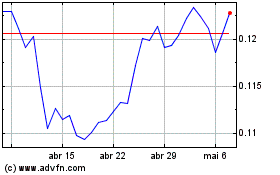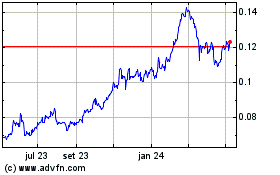Bitcoin Meets Fiscal Reality: Fidelity’s Timmer Predicts What’s Next
19 Fevereiro 2025 - 5:00AM
NEWSBTC
In a note published on Tuesday, Jurrien Timmer, Director of Global
Macro at Fidelity Investments, discusses how a shifting economic
landscape could influence markets, central bank policy, and the
trajectory of both Bitcoin and gold. With the S&P 500 hitting
new highs and the so-called “Trump Trade” reversing course, Timmer
offers nuanced insights into fiscal policy, inflation, and the role
of risk assets in a “limbo” market environment. The Trump Effect
Timmer observes that the first six weeks of 2025 have brought
unexpected market moves and an unusually high “noise-to-signal
ratio.” The dominant market expectation coming into the
year—anticipating “higher yields, a stronger dollar, and
outperforming US equities”—has abruptly flipped. He notes: “It
seems so 2025 that the consensus trade of higher yields, a stronger
dollar, and outperforming US equities has turned into the
opposite.” Timmer highlights that Bitcoin, fresh off a year-end
rally, remains on top of rolling three-month return rankings,
followed closely by gold, Chinese equities, commodities, and
European markets. At the lower end of the table, the US dollar and
Treasuries are bringing up the rear. Related Reading: Bitcoin To
$500,000: Standard Chartered Doubles Down On 2028 Target Despite
the S&P 500’s record levels, Timmer calls this a “digestion
period” following the post-election optimism. He explains that the
market beneath the headline index is much less decisive. According
to Timmer, the equal-weighted index remains on hold, with only 55%
of stocks trading above their 50-day moving averages. “Sentiment is
bullish, credit spreads are narrow, the equity risk premium (ERP)
is in the 10th decile, and the VIX is at 15. The market appears to
be priced for success.” Timmer underscores that while earnings
growth was robust at 11% in 2024, revisions appear lackluster, and
there are open questions about what might happen if long-term rates
climb towards 5% or beyond. One of the most critical pieces of
Timmer’s analysis centers on Federal Reserve policy. He points to
the recent CPI report, with a year-over-year core inflation figure
of 3.5%, as a near-consensus indicator that the Fed will remain on
pause. “It’s now all but unanimous that the Fed is on hold for some
time to come. That’s exactly right, in my view. If neutral is 4%, I
believe the Fed should be a smidge above that level, given the
potential likelihood that ‘3 is the new 2.’” He warns about the
possibility of a “premature pivot,” recalling the policy mistakes
from the 1966–1968 period, when rate cuts happened too early,
ultimately allowing inflation to gain a foothold. With the Fed
apparently sidelined, Timmer believes the next market driver for
interest rates will come from the long end of the curve.
Specifically, he sees tension between two scenarios: one featuring
endless deficit spending and rising term premiums—hitting equity
valuations—and another emphasizing fiscal discipline, which would
presumably rein in long-dated bond yields. Timmer also remarks that
weekly jobless claims may come into sharper focus for bond markets,
given how government spending under the new administration could
influence employment data. Related Reading: Bitcoin’s Final Dip
Before $273,000? A Market Veteran Thinks So Timmer points out a
potential bullish pattern—a head-and-shoulders bottom—in the
Bloomberg Commodity Spot Index. Though he stops short of calling it
a definitive shift, he notes that commodities remain in a broader
secular uptrend and could see renewed investor interest if
inflation pressures stay elevated or fiscal conditions remain
loose. Gold, he notes, has been “a big winner” in recent years,
outperforming many skeptics’ expectations: “Since 2020, gold has
produced almost the same return as the S&P 500 while having a
lower volatility. In my view, gold remains an essential component
of a diversified portfolio in a regime in which bonds might remain
impaired.” Timmer sees gold testing the critical $3,000 level amid
a global uptick in money supply and a decline in real yields.
Historically, gold has shown a strong negative correlation with
real yields, though Timmer believes the metal’s strength of late
may also reflect fiscal rather than monetary dynamics—particularly,
geopolitical demand from central banks in China and Russia. Bitcoin
Vs. Gold According to Timmer, the outperformance of both gold and
Bitcoin has “sparked a lot of conversation about monetary
inflation.” However, he draws a distinction between the “quantity
of money” (the money supply) and the “price of money” (price
inflation). “The point of this exercise is to show that the growth
in traditional asset prices over time can’t just be explained away
by monetary debasement (which is a favorite pastime of some
bitcoiners),” he writes. Timmer’s charts suggest that while nominal
M2 and nominal GDP have moved in near lockstep for over a century,
consumer price inflation (CPI) has lagged somewhat behind money
supply growth. He cautions that adjusting asset prices solely
against M2 may produce misleading conclusions. Still, his analysis
finds that both Bitcoin and gold have strong correlations to M2,
albeit in different ways: “It’s interesting that there’s a linear
correlation between M2 and gold, but a power curve between M2 and
Bitcoin. Different players on the same team.” Timmer highlights
gold’s long-run performance since 1970, noting that it has
effectively kept pace—or even exceeded—the value created by many
bond portfolios. He sees gold’s role as a “hedge against bonds,”
especially if sovereign debt markets remain pressured by fiscal
deficits and higher long-term rates. Timmer’s note underscores that
Bitcoin’s strong performance cannot be seen in isolation from gold
or the broader macroeconomic environment. With yields in flux and
policymakers grappling with deficits, investors may be forced to
reassess the traditional 60/40 portfolio model. He emphasizes that
while past expansions of the money supply have often spurred
inflation, the relationship is not always one-to-one. Bitcoin’s
meteoric rise could, in Timmer’s view, reflect a market perception
that fiscal concerns—not just monetary policy—are driving asset
prices. “And as you can see from the dotted orange line and the
green line, Bitcoin has added the same amount of value that
overnight money took over 300 years to create,” he concluded. At
press time, BTC traded at $95,700. Featured image from YouTube,
chart from TradingView.com
TRON (COIN:TRXUSD)
Gráfico Histórico do Ativo
De Jan 2025 até Fev 2025

TRON (COIN:TRXUSD)
Gráfico Histórico do Ativo
De Fev 2024 até Fev 2025
